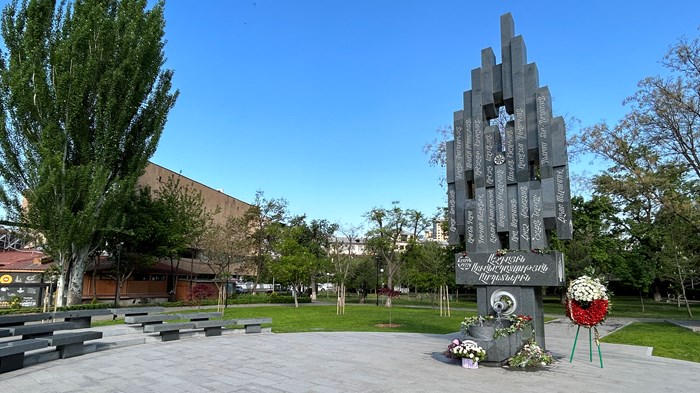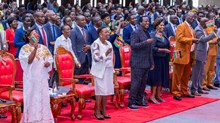
Surveying the scene on a rainy day in Berlin, the Protestant gunman recognized his target. Living hidden under an assumed name in the Weimar Republic, the once-famous official exited his apartment, was shot in the neck, and fell in a pool of blood.
For many, the 1921 killing vindicated the blood of thousands.
Neither were Germans. Both would eventually be immortalized.
But the cloak-and-dagger story took another twist when a Berlin court ruled the assassin “not guilty.” The trial captivated the local press, brought a nation’s tragedy to the public eye, and set off a philosophical chain of events that eventually coined a new term and established an international convention meant to render unnecessary any similar future acts.
It was already too late.
Two decades after the trial, the Nazis murdered six million Jews. Hitler, preparing the Holocaust, is said to have justified it in reference to the already forgotten history of 1.5 million people killed by Germany’s then-ally in the fallout from World War I.
The gunman, Soghomon Tehlirian, was an Armenian. The official, Mehmed Talaat, was an Ottoman Turk. And the term created by Polish lawyer Raphael Lemkin—genocide—continues to haunt the world today.
But the chain of events has not concluded.
Nazi Germany, seeking Axis partners in World War II, repatriated Talaat’s remains to Turkey in 1943, where dozens of memorials and streets are named in his honor. Once the grand vizier of the Ottoman sultan, he is celebrated today as one of the leading “Young Turks” who forged the creation of the modern-day secular nationalist republic.
The descendants of his victims, scattered around the world, consider Talaat—known commonly as Talaat Pasha with his honorific title—the architect of the Armenian Genocide.
Tehlirian, who in prison pending trial was given a Bible by a local Protestant pastor, eventually settled in the United States. He is buried in Fresno, California, where his obelisk-shaped grave marker is adorned with a gold-plated eagle, slaying a snake.
And last month, more than a century after the trial, the city council of Yerevan, the capital of Armenia, erected a memorial to honor 16 heroes of Operation Nemesis. Conducted between 1920–22, the campaign secretly authorized by the ruling party of the newly independent nation assassinated eight Turkish and Azerbaijani officials.
It was named after the Greek goddess of divine retribution.
Incorporating a fountain of flowing water, the memorial’s towering structure was built based on a petition from the Descendants of the Avengers of the Armenian Genocide. Tehlirian is at the center, beneath an empty space in the shape of a cross, directing one’s gaze upward to heaven.
Does heaven approve—now or then?
“If I was at the planning meeting, I couldn’t do it because of my faith,” said Craig Simonian, an Armenian pastor. “But people reap what they sow.”
Also the Caucasus Region coordinator for the World Evangelical Alliance’s (WEA) Peace and Reconciliation Network, Simonian said he would struggle with calling the operation morally wrong. The sultan whom Talaat served was a “butcher,” he said, and the pastor’s own relatives were driven from the region of Diyarbakir.
“You can’t understand how it feels that so many of those guys got away with it,” Simonian said. “But even so, ‘Thou shalt not murder’ does not come with 30 footnotes.”
Tehlirian exempted himself from the label.
“I do not consider myself guilty because my conscience is clear,” he said to the court a century ago. “I have killed a man. But I am not a murderer.”
Instructed not to flee the scene, Armenian plotters desired the trial and turned it into a referendum on the genocide. The defense strategy portrayed Tehlirian as traumatized by loss, and called witnesses to describe the rape, killing, and death marches suffered at the direct order of Talaat and others.
The court was convinced, as Khatchig Mouradian is today.
“As there was no international legal framework to hold them accountable, the survivors took justice into their own hands,” said the Columbia University historian. “Lemkin felt that Tehlirian ‘upheld the moral order of mankind,’ so I’ll side with him on this one.”
In the chaotic aftermath of World War I, new Ottoman leadership brought 63 court-martial cases against 200 officials, handing out 16 death penalties—most in absentia. Talaat and others were found guilty, but escaped. Others were captured by the British, but were traded for compatriot prisoners. And when Young Turk sympathizers returned the movement to power, the local judicial process was abandoned.
But it gave birth to the global cause.
That “fateful encounter on the streets of Berlin,” said Mouradian, led directly to the 1948 United Nations Genocide Convention. But though Operation Nemesis—which in Greek means “to give what is due”—commands the widespread respect of the Armenian people, the Armenian Apostolic Orthodox church was a bit uncomfortable. Tehlirian approached the Constantinople patriarch for funds, but only received a blessing.
“I cannot take part in such endeavors, my son,” said Zaven Der Yeghiayan, as recounted in the assassin’s memoirs.
The church today is similar.
“From the point of view of Christian ethics, any murder is considered a sin,” said Shahe Ananyan, dean of Armenia’s Gavorkian theological seminary, relating the official church position on the operation. “But it should also be seen in the context of resistance and self-protection.”
Calling the Ottoman plans “demonic,” the Apostolic priest said that Armenian efforts to defend their people—even when using violence—qualified as legitimate just-war measures to protect the innocent. But in contrasting this with Turkish denial and the contemporary movement to honor the Young Turks, Ananyan fears the rise of new “genocidal tendencies.”
In protest to the new monument, Turkey closed its airspace to Armenia.
But Operation Nemesis, said Ananyan, is similar to Jewish acts of revenge against the Nazis, and simply reflected a longing for the restoration of justice.
One contemporary Turk agrees.
“Unfinished justice pushes individuals to take justice into their own hands—this is the testimony of history,” said Taner Akcam, author of Killing Orders: Talat Pasha’s Telegrams and the Armenian Genocide. “Alongside revenge, the cry for justice runs very deep in the human species.”
A third instinct—recognition of suffering—is reflected in Yerevan’s monument.
Widely recognized as one of the first Turkish scholars to study this period, Akcam directs the Armenian Genocide Research Program at UCLA. But even more valuable than the Tehlirian court proceedings, he said, would be the evidence collected by the Ottoman military tribunals—including hundreds of telegrams and the testimonies of bureaucrats.
Today, he said, Turkey buries it.
While the official archives are open, Akcam said that when asking about the “Special Operation” which oversaw the deportation of Armenians, “no one knows” where the records are.
And when the government decided in 2006 to open the deed office to researchers, national security quickly shut it down. It would have revealed the pre-genocide property ownership of thousands of Armenians. In 1926, the government assigned such property to the relatives of Talaat and other assassinated officials.
“Without an honest accounting of history,” Akcam said, “Turkey isolates itself more and more from the civilized world.”
The scholar, however, is not the only Turk unsettled in spirit. When Simonian visited a mosque in Adana on Turkey’s southeastern Mediterranean coastline, local guides told him it was built with the gold seized from deported Armenians.
And later when interacting with a young Turkish woman who thought he was a simple tourist, Simonian told her his visit was a pilgrimage to discover the land of his forefathers. Startled, she tearfully replied: I don’t know how our grandparents did this, to yours.
She accepted his prayers, then told him that God had removed a great weight.
“Our ancestors bring us either blessing or curse,” Simonian said. “But it is hard to go deeper into the past, when we have real issues to discuss right now.”
Among them is the ongoing blockade of Nagorno-Karabakh.
The mountainous Caucasus enclave is home to over 100,000 ethnic Armenians, who call their historic homeland Artsakh. But the international community recognizes the land as Azerbaijani territory—recaptured from independence-seeking Armenian control in 2020 after a 44-day war. Only one road connects it to Armenia, and since December Azerbaijani activists have sealed off the area from all but humanitarian deliveries, ignoring an International Court of Justice ruling.
Like Turkey, Baku leaders have denounced the memorial.
Azerbaijan insists upon Armenian recognition of its sovereignty over Nagorno-Karabakh. Last week, Armenian prime minister Nikol Pashinyan signaled readiness to accept, if local rights are guaranteed. Many Armenians, however, dismiss Azerbaijani statements about accepting Armenians as citizens, and focus instead on Baku’s expanding territorial hints that reach even to Yerevan.
But peace is needed also toward Armenia’s west.
On-and-off again negotiations resumed following Yerevan’s delivery of humanitarian aid to victims of the earthquake in Turkey, and appeared to be making progress. But with the closure of airspace, Turkish officials said further retaliatory measures would be taken if Armenia did not remove the monument.
The speaker of Armenia’s parliament said it was not meant as an “unfriendly act,” and did not represent official foreign policy. Pashinyan called installation of the memorial a “wrong decision” taken by the local council, not the national government.
“But by being always guided by the logic of … not being called traitors,” the prime minister stated, “we actually keep betraying the state and national interests of our country.”
Vazgen Zohrabyan agrees, beyond his training as a political analyst.
“Anything that suggests revenge worries me as a pastor,” said the leader of Abovyan City Church, northeast of Yerevan. “Such approaches will not bring any benefit in terms of the reconciliation of nations, or the reconciliation of peoples.”
Proud of Nemesis as an operation, Zohrabyan said that Tehlirian is a symbol of justice and that Protestants have always been active in the national cause. He cited the 1915 defense of Musa Dagh as an example, with significant leadership provided by evangelical pastors. And the retribution against Ottoman officials addressed the deep wound caused by the Armenian people’s uprooting from a historic homeland.
Artyom Yerkanyan has similar reflections.
His father, Aram, is enshrined on the monument for the assassination of an Azerbaijani official responsible for the killing of 30,000 Armenians in Baku.
“Can you imagine what would have happened if Operation Nemesis hadn’t happened? We would be a sick nation, suffering from psychological complications,” he stated at the public ceremony.
“I often compare them to psychiatrists. They made us feel worthy.”
But the unfortunate result today, said Zohrabyan, is that the memorial serves to cement animosity. It is understandable, as hostile rhetoric has increased from Azerbaijan, backed by the historic Turkish enemy. The task, however, is to work with both neighbors toward peace—and avoid needless antagonism.
“We are obliged to take steps so that the Turks consciously apologize for what was done,” said Zohrabyan, “and that the Armenians can find the strength to forgive.”
Such ruminations about the memorial, said Eric Hacopian, an Armenian political analyst, put the pastor in a distinct minority. Few ordinary citizens even noticed its installation, let alone felt a moral dilemma.
“The whole issue is a nothingburger,” he said, with national sentiment worried about cross-border attacks and a possible new genocide in Artsakh. “I don’t expect much soul searching about it.”
Should Americans, he asked, be disturbed by the killing of Osama bin Laden? And while there is little popular sentiment aligned with the Yerevan government about the timing of the monument, almost no one in Armenia would oppose it in principle.
Neither does Simonian.
Unlike Zohrabyan, he does not equate the memorial with commemorating vengeance, which is prohibited to the believer. Instead, like statues in America of slaveholding national heroes, it reflects the reality of history and prompts further conversation.
Yet despite his WEA mandate, amid Turkish “hypocrisy” he believes there is little reconciliation on the horizon.
“You can’t reconcile with someone who is still hurting you,” Simonian said. “What the monument says is that we need this to end.”
As for Operation Nemesis itself, it forced the world to recognize the genocide. He hopes the current controversy will bring attention to the crisis in Artsakh. But while the recognition of missing justice can be a salve to a suffering people, no one should think—as he once felt himself—that they got away with it.
And this truth, more than any memorial, facilitates genuine healing.
“Nothing Tehlirian did can compare with God’s justice on an unrepentant heart,” said Simonian. “This truth allows us to forgive, if we can submit our desire for revenge to the sovereignty of God.”

Support Our Work
Subscribe to CT for less than $4.25/month


















